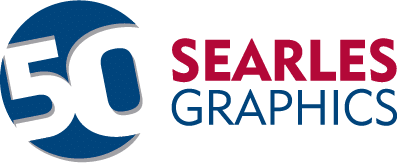Printing has long been the backbone of communication, even more so in the business world where it forms the bridge between ideas and tangible reality. More and more studies are showing how important it is to go beyond the screen to connect with your customers.
At Searles Graphics, we’re passionate about providing a variety of printing methods to cater to your unique needs.
This comprehensive guide is here to walk you through the different printing methods available for your project and help you understand which one aligns with your project requirements.
Offset Lithography
Offset printing is a widely used printing technique, especially suited for high-volume print jobs. The process begins by transferring an image onto a metal plate, then to a rubber blanket, and finally onto the printing surface.
This method is known for producing clear, clean, and crisp images and is often used for printing books, newspapers, stationery, and much more. Offset lithography is highly efficient for large print runs, making it a go-to choice for many businesses.
Digital Printing
Welcome to the digital age! Digital printing is a relatively modern method that stands out for its speed and precision. Unlike offset printing, digital printing doesn’t require plates, which reduces setup time and costs.
This method shines for lower volume projects and allows for easy customization, which makes it a terrific option for personalized marketing campaigns. Digital printing technology has evolved rapidly, and the quality now closely matches that of offset printing.
Flexography
Flexography, often referred to as flexo, is a method commonly employed for printing on packaging and labels. It utilizes flexible relief plates and fast-drying inks, making it a reliable choice for large orders with varying substrates.
The versatility of flexography makes it a preferred method for printing on non-porous materials like plastic, cellophane, and metallic film.
Screen Printing
Screen printing, or silkscreen printing, is a technique where ink is pushed through a mesh screen onto the printing surface. It’s favored for its versatility and is commonly used for printing on apparel, banners, and signage.
Screen printing offers a high level of vibrancy, making it a preferred choice for bold and creative designs.
Letterpress Printing
A classic from the annals of printing history, letterpress printing creates a beautiful, handcrafted feel. It’s known for delivering an elegant, embossed look, making it a favored choice for high-end invitations, business cards, and other specialized products.
The tactile experience of letterpress printing has led to a resurgence in its popularity, especially among artisanal and boutique businesses.
Gravure Printing
Gravure printing is synonymous with high-quality, high-volume printing. It was once a preferred method for printing large runs of magazines, catalogs, and other multi-page documents. However, as those runs have gotten shorter and shorter, this process is not as widespread as it once was.
Gravure printing provides exceptional quality and consistency over long print runs, although the initial setup costs can be higher compared to other methods.
Commonly Asked Questions About Printing Methods
These are questions that often pop up regarding printing methods, and the answers can vary based on the person asking and the goals they’re trying to accomplish. Here are some concise answers to some common print method questions:
What are the 8 types of printing methods?
- Digital Printing: A method that reproduces digital images on physical surfaces.
- Screen Printing: Involves pushing ink through a mesh screen onto the printing surface.
- Flexography Printing: Commonly used for packaging and labels, using flexible plates.
- Litho Printing (Offset Lithography): Ideal for high-volume print jobs, transferring images from a metal plate to a rubber blanket to the printing surface.
- Transfer Printing: Transfers digital images onto various materials.
- Engraving: Carves designs onto a surface, which are then inked to transfer the design.
- Embossing: Creates a raised or 3D effect on the printing surface.
- Embroider Printing: Designs are stitched onto fabric, commonly used for apparel like hats and jackets.
What are the 4 main types of printmaking?
- Relief Printing: Printing from a raised surface, like a rubber stamp pressed into a stamp pad.
- Intaglio: Printing is done from ink that is below the surface of the matrix, in grooves or cavities.
- Planographic: In this method, the printing surface is flat, and the image areas are chemically treated to accept ink.
- Stencil: Involves placing a stencil on the printing surface and applying ink or paint over the stencil, creating a design when the stencil is removed
What are the other methods of printing?
- Dye Sublimation Printing: Utilizes heat to transfer dye onto materials such as plastic, card, paper, or fabric.
- Thermography Printing: Creates a raised effect by melting powder onto the ink.
- Pad Printing: Uses a silicone pad to transfer the image from a plate to the product.
- Electrostatic Printing: Similar to photocopying, it uses toner and electric charge to print onto the substrate.
- 3D Printing: Builds objects layer by layer from digital models.
- Laser Printing: Uses static electricity to transfer a digital image onto paper.
- Inkjet Printing: Propels droplets of ink onto the substrate.
What are the 3 main printing processes?
- Digital Printing: Includes methods like inkjet and laser printing, direct to substrate printing without the need for a printing plate.
- Offset Printing (Offset Lithography): Involves transferring an image from a plate to a rubber blanket and then onto the printing surface.
- Flexographic Printing: Utilizes flexible printing plates to transfer ink onto various substrates, often used for packaging and labels.
Why Print Methods Matter
Choosing the right printing method is crucial to ensure the success of your project. Each method comes with its unique set of advantages and can significantly impact the quality, cost, and turnaround time of your project.
At Searles Graphics, we offer a consultative approach, guiding you through the selection process to ensure a perfect match between your project and the printing method. If you’re looking for printing companies on Long Island, feel free to explore our printing services page for a deeper insight into our offerings.
Whether you are a small business, a non-profit organization, or a large enterprise, understanding the printing methods available can empower you to make informed decisions for your printing needs. With the right printing method, you can ensure a seamless process from concept to completion, achieving the desired impact for your brand.


